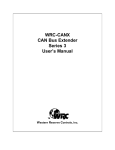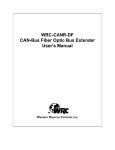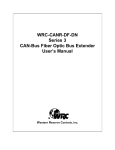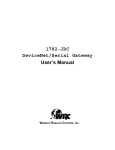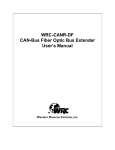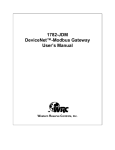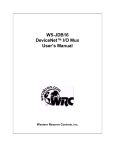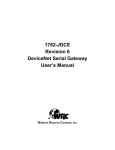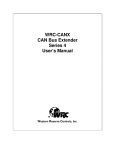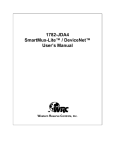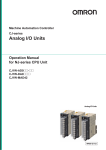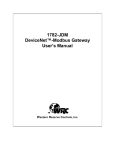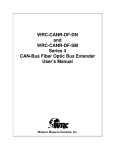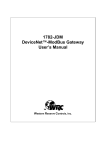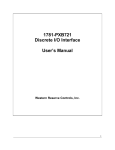Download WRC-CANX Version 2 user`s manual revision 2.15
Transcript
WRC-CANX CAN Bus Extender, Version 2 User’s Manual W estern Reserve Controls, Inc. Western Reserve Controls PUB 14.0 WRC-CANX-xx User’s Manual Although every effort has been made to insure the accuracy of this document, all information is subject to change without notice. WRC takes no liability for any errors in this document or for direct, indirect, incidental or consequential damage resulting from the use of this manual. Document PUB 14.0 Rev 2.15 March 2002 Copyright © 1997 – 2002 WRC Western Reserve Controls, Inc. 1485 Exeter Road Akron OH 44306 330-733-6662 (Phone) 330-733-6663 (FAX) [email protected] (Email) http://www.wrcakron.com (Web) SmartMux-Lite, CAN-Bus Extender and WRC are trademarks of Western Reserve Controls, Inc. DeviceNet is a trademark of the Open DeviceNet Vendor Association, Inc. (“ODVA”). SDS is a trademark of the Honeywell, Inc. All other trademarks are property of their respective companies. TABLE OF CONTENTS 1. 1.1. 1.2. 1.3. 1.4. OVERVIEW ............................................................................................................................................................................ 3 FEATURES............................................................................................................................................................................3 BASIC OPERATION .............................................................................................................................................................4 ORDERING OPTIONS...........................................................................................................................................................4 REFERENCE DOCUMENTS.................................................................................................................................................5 2. USING THIS MANUAL......................................................................................................................................................... 6 3. QUICK START....................................................................................................................................................................... 7 4. GENERAL SPECIFICATIONS ............................................................................................................................................ 8 5. HARDWARE INSTALLATION AND CONFIGURATION............................................................................................ 9 5.1. OVERVIEW ...........................................................................................................................................................................9 5.2. DIP SWITCH SETTINGS ...................................................................................................................................................11 5.2.1. Slide Switch Version.............................................................................................................................................11 5.2.2. Piano Switch Version ...........................................................................................................................................12 5.3. LED OPERATION ..............................................................................................................................................................12 5.4. POWER REQUIREMENTS..................................................................................................................................................14 5.5. NETWORK CABLING AND CONFIGURATION................................................................................................................14 5.5.1. Cable Lengths........................................................................................................................................................14 5.5.2. Network Termination ...........................................................................................................................................15 5.5.3. DeviceNet Connection Wiring............................................................................................................................17 5.5.4. SDS Bus Connection Wiring ...............................................................................................................................19 6. OPERATION ........................................................................................................................................................................20 6.1. A PPLICATION NOTES......................................................................................................................................................20 6.1.1. General Installation .............................................................................................................................................21 6.1.2. CANX Theory of Operation .................................................................................................................................21 6.1.3. Network Throughput Design Considerations .................................................................................................21 6.1.4. Fixed Operation ....................................................................................................................................................22 6.1.5. Autobaud Operation.............................................................................................................................................22 6.1.6. Example Configurations......................................................................................................................................22 7. ACCESSORIES AND OTHER CAN PRODUCTS ........................................................................................................24 8. TROUBLESHOOTING.......................................................................................................................................................26 Western Reserve Controls PUB 14.0 WRC-CANX-xx User’s Manual LIST OF FIGURES FIGURE 1-1 TYPICAL CANX NETWORK CONFIGURATIO N....................................................................................................4 FIGURE 5-1 WRC-CANX-DIN CAN-BUS EXTENDER................................................................................................................9 FIGURE 5-2 WRC-CANX-NEM CAN-BUS EXTENDER............................................................................................................10 FIGURE 5-3 WRC-CANX-NEM-DN..............................................................................................................................................11 FIGURE 5-4 DIP SWITCH SETTING FOR BAUD RATE – SLIDE SWITCH .................................................................................11 FIGURE 5-5 DIP SWITCH SETTINGS – PIANO SWITCH ONLY ................................................................................................12 FIGURE 5-6 WRC-DANX-DIN-DN DEVICE NET CABLE CONNECTOR ..................................................................................17 FIGURE 5-7 DEVICE NET CABLE SPECIFICATIONS....................................................................................................................17 FIGURE 5-8 WRC-CANX-NEM POWER AND DEVICE NET CONNECTORS..............................................................................18 FIGURE 5-9 SDS M INI CONNECTOR .............................................................................................................................................19 FIGURE 6-1 CANX ON A DROP LINE ............................................................................................................................................23 FIGURE 6-2 CANX ON TRUNK LINE AND DROP .........................................................................................................................23 LIST OF TABLES TABLE 1-1 CANX ORDERING OPTIONS ......................................................................................................................................5 TABLE 5-1 BAUD RATE SETTINGS FOR SLIDE SWITCHES.......................................................................................................11 TABLE 5-2 BAUD RATE SETTINGS – PIANO SWITCH ONLY ..................................................................................................12 TABLE 5-3 MODULE S TATUS LED (LABELED MS)...................................................................................................................13 TABLE 5-4 NETWORK STATUS LED’S (LABELED NSA AND NSB).........................................................................................13 TABLE 5-5 DIAGNOSTIC STATUS LED’S (LABELED DGN)........................................................................................................14 TABLE 5-6 NETWORK M AXIMUM LENGTHS - DEVICE NET .....................................................................................................14 TABLE 5-7 NETWORK M AXIMUM LENGTHS - SDS...................................................................................................................15 TABLE 5-8 TERMINATING RESISTORS..........................................................................................................................................15 TABLE 7-1 A DDITIONAL WRC DEVICE NET PRODUCTS..........................................................................................................25 2 Western Reserve Controls PUB 14.0 1. WRC-CANX-xx User’s Manual Overview The WRC-CANX Extenders is a family of products that extend the communications cable lengths for DeviceNet, SDS (Smart Distributed System) and other CAN, V2.0, Part A, serial bus systems. By allowing the user to extend the bus length for any given speed, they assist the user in cost-effectively implementing I/O or other nodes on these buses at remote locations that would be more difficult or more expensive to do otherwise. A WRC-CANX Extender (the family members collectively referred to here as CANX or Extender) can be connected in a bus trunk line or drop line and is transparent to the other nodes on the bus. It receives and actively re-transmits (store-and-forward) each message from either side of the network without interpreting the message or acting upon it. Each product has two network interfaces with an electrical isolation path between the two. Power is delivered to the unit through the network connectors. For DeviceNet and SDS systems power is provided through the 5-conductor bus cable. 1.1. Features The WRC-CANX has the following features: • • • • • Extends CAN-Bus cable lengths - trunk line or drop lines Expands the usable applications for CAN-Bus systems Operates at 125K, 250K and 500K baud Allows operation at higher speeds for specific distances No configurable parameters • Automatic baud rate selection • No address selection required • Isolates the two sides of the bus - 2500 volts • Logically transparent to the Master and Slave devices on the bus • DeviceNet; SDS; CAN, V2.0, Part A compatible • Powered from the 24Vdc supplied by bus network or the user •Two mechanical packages: DIN rail mount: WRC-CANX-DIN Sealed NEMA-4X enclosure: WRC-CANX-NEM • 5-pin pluggable connection for the DIN mount unit • 5-pin round mini-style connection for the NEMA mount unit • Standard CAN chips manage bus error detection • Standard CAN chips handle message bus contention • Less than 100 µsec latency • 3 bi-color (red/green) status LED's • 1 red diagnostic LED • CE Compliant for WRC-CANX-NEM-xx versions •EN 55011 Class A •EN 50082-2: 1994 3 Western Reserve Controls PUB 14.0 WRC-CANX-xx User’s Manual 1.2. Basic Operation There are two bus connections for each CANX, referred to as Network A and Network B. The CAN Bus is connected to each side of the CANX and each side receives its power and signals from the Bus on its respective side. See Figure 1-1 for a typical application. Whenever a message is transmitted on the Bus to which CANX is connected, CANX receives the message on the side where it was initiated and performs a store-and-forward of the message to the other side. It then transmits the message to the bus on the other side, following the defined bus arbitration rules. This action is performed for any valid CAN message independent of who generated it or to whom it is intended. There is approximately a 75 µsec propagation delay of the message through the CANX. The CANX is not addressed as a specific device on the Bus and cannot be interrogated by other nodes. It is transparent to all other nodes on the bus. CAN-Bus T Master Network A WRC-CANEXT T A T Network B T B PS PS I/O Nodes I/O Nodes Terminating resistors indicated by “T” Figure 1-1 Typical CANX network configuration 1.3. Ordering Options Several options are available, depending upon which bus network is used and which package choice is desired. 4 Western Reserve Controls PUB 14.0 WRC-CANX-xx User’s Manual Table 1-1 CANX Ordering Options Bus Network DIN Mount NEMA Enclosure DeviceNet WRC-CANX-DIN-DN WRC-CANX-NEM-DN SDS WRC-CANX-DIN-SD WRC-CANX-NEM-AU (see Figure 5-8 WRC-CANXNEM Power and DeviceNet Connectors for differences) WRC-CANX-NEM-SD Other CAN Bus WRC-CANX-DIN-CU WRC-CANX-NEM-CU 1.4. Reference Documents The following documents are referenced in this User’s Manual • ODVA DeviceNet Specification Volume I, Release 2.0 • Honeywell Micro Switch Specification GS 052 104, “SDS Smart Distributed System Physical Layer Specification”, release date 12/8/1994 5 Western Reserve Controls PUB 14.0 2. WRC-CANX-xx User’s Manual Using This Manual This manual serves to help the user to understand the capabilities of the CAN-Bus Extender product family and how to install and configure an I/O subsystem using these products. Section 3 describes how to quickly connect your WRC-CANX and get it up and running on the DeviceNet, SDS or other CAN-Bus link. Section 4 provides the technical specifications for the products. Section 5 describes the installation of the hardware, including mounting, cabling, connection to other I/O subsystem components, and power requirements. Section 6 provides some additional operational information. Section 7 lists common accessories that are used with the WRC-CANX. Section 8 provides some troubleshooting hints in the event your CAN-Bus Extender is not operating as anticipated. 6 Western Reserve Controls PUB 14.0 3. WRC-CANX-xx User’s Manual Quick Start To quickly and easily install your CAN-Bus Extender in your DeviceNet system, follow the instructions below. For more details, see Section 5. To Install and Establish Communications 1. Remove the CAN-Bus Extender from the box and connect your CAN-Bus cable to the 5-pin plugs (supplied with CANX-DIN) or the mini-style connectors (user-supplied) according to wiring specifications for the CAN Bus you are using and described later in this manual. 2. Set the DIP switch (switches 5-6) to the desired baud rate. (ON-ON = 125k, ON-OFF = 250k, OFF-ON = 500k, OFF-OFF = autobaud.) 3. Identify the two sides of the Bus as Network A and Network B. In a Master/Slave configuration, define Network A as the side toward the Master. Identify Network B as the part of the Bus away from the Master. 4. Terminate each side of the CAN-Bus network, as appropriate. (This is especially critical at the higher baud rates.) 5. Make sure that there is power on the CAN-Bus Network A and plug the Network A cable into the CANBus Extender on the side marked Network A. 6. The CAN-Bus Extender will undergo its initialization sequence, flashing the LED’s. After approximately 5 seconds, the Module Status LED (labeled “MS”) will go on solid green and network LED’s (labeled “NSA” and “NSB”) will flash green. Note: For Autobaud, Network Side A must be powered up first. 7. Make sure that there is power on the CAN-Bus Network B and plug the Network B cable into the CANBus Extender on the side marked Network B. 8. Both Network A and B Status LED’s (NSA and NSB) will go on solid once a valid CAN message is received into either side of the Extender and the baudrate auto-detect has been successfully performed. 9. The CAN-Bus Extender is now operating on the network and is ready to repeat messages from either Network A or Network B. 7 Western Reserve Controls PUB 14.0 4. WRC-CANX-xx User’s Manual General Specifications Product: WRC-CANX-DIN and WRC-CANX-NEM CAN-Bus Extender Description: Electrical extender to extend the permitted cable distances defined for CANbased network products Device Type: Communications Extender Product Revision: 2 DeviceNet Conformance: Designed to conform to the ODVA DeviceNet Specification Version 2.0. Baud rate: 125K, 250K, 500K, 1M - automatic selection Address selection: Not applicable Bus Connection: WRC-CANX-DIN Extender: CAN-Bus Cable: WRC-CANX-NEM Extender: 5-pin pluggable header (male pins) Phoenix Contact MSTBA 2.5/5-G-5.08/AU 5-contact plug (female contacts) Phoenix Contact MSTB 2.5/5-ST-5.08/AU (included) CAN-Bus Cable: Turck # RKF50, female sockets, female threads Turck # RSF50, male pins, male threads See accessories list Status Indicators: Module Status: Network A Status: Network B Status: Diagnostic Data: green/red bi-color LED green/red bi-color LED green/red bi-color LED green/red bi-color LED Voltage Isolation: 2500 V Maximum power: Voltage: Current: Mounting: WRC-CANX-DIN: WRC-CANX-NEM: DIN rail mount, EN 50022 Panel-mount, 4 screws Length: Depth: Height: WRC-CANX-DIN 4.32” (110 mm) 1.79” (45,5 mm) 3.44” (87,4 mm) 11 - 25 Vdc Network A: 140 mA @ 11 Vdc - 60 mA @ 25 Vdc Network B: 20 mA @ 11 Vdc - 10 mA @ 25 Vdc Power: 1.8 W Size: Operating Temp: 0-70 ºC Humidity: 0-95% RH, non-condensing 8 WRC-CANX-NEM 5.11” (130 mm) 2.27” (57,7 mm) 3.70” (94,0 mm) Western Reserve Controls PUB 14.0 5. WRC-CANX-xx User’s Manual Hardware Installation and Configuration 5.1. Overview A CAN-Bus Extender is a single device connected to two parts of a single CAN-Bus network. The CANX-DIN is to be mounted on an EN50022 DIN rail (available from WRC and WRC’s distributors as part number WRC 50022) in any orientation. The CANX-NEM is a NEMA-4X enclosure and is panel mounted. DGN NSA MS 1.79” ( 45,5 mm) SW1 NSB 4.65” (118 mm) Figure 5-1 WRC-CANX-DIN CAN-Bus Extender 9 NETWORK B NETWORK A Western Reserve Controls PUB 14.0 WRC-CANX-xx User’s Manual DGN MS SW1 NSB 5.11” (130 mm) Figure 5-2 WRC-CANX-NEM CAN-Bus Extender Network A Power NETWORK B NETWORK A Network B Power ` ` 10 0.29” (7,4 mm) 2.27” ( 57,7 mm) NSA NETWORK B NETWORK A 0.29” (7,4 mm) Western Reserve Controls PUB 14.0 WRC-CANX-xx User’s Manual Figure 5-3 WRC-CANX-NEM-DN 5.2. DIP Switch Settings The WRC-CANX-XX Multiplexer has a 6-pole DIP switch. Switch positions 5 and 6 are used to set the baud rate. (Switch positions 1-4 are reserved for future functions.) The CANX has shipped with 2 styles of DIP switches – slide and piano. The following sections describe the settings for each style. 5.2.1. Slide Switch Version Table 5-1 Baud Rate Settings for Slide Switches Baud rate 125K 250K 500K Autobaud Position 1-4 n/a n/a n/a n/a Position 5 Position 6 ON ON OFF OFF ON OFF ON OFF 125k baud 250k baud 500k baud Autobaud Figure 5-4 DIP Switch Setting for Baud Rate – Slide Switch 11 Western Reserve Controls PUB 14.0 WRC-CANX-xx User’s Manual 5.2.2. Piano Switch Version Table 5-2 Baud Rate Settings – PIANO Switch Only Baud rate 125K 250K 500K Autobaud Position 1-4 n/a n/a n/a n/a Position 5 Position 6 CLOSE CLOSE OPEN OPEN CLOSE OPEN CLOSE OPEN 125k baud 250k baud 500k baud Autobaud Figure 5-5 DIP Switch Settings – PIANO Switch Only 5.3. LED Operation The WRC-CANX-XX Multiplexer has four (4) LED’s that provide visual status information to the user about the product and the DeviceNet network. See Figure 5-1, Figure 5-2 Table 5-3 and Table 5-4. 12 Western Reserve Controls PUB 14.0 WRC-CANX-xx User’s Manual Table 5-3 Module Status LED (labeled MS) LED State Module Status Meaning OFF No Power There is no power through DeviceNet. Green Device Operational WRC-CANX is operating normally. Flashing Green Device in Standby WRC-CANX is in initialization. Flashing Red Minor Fault Recoverable fault. Red Unrecoverable Fault WRC-CANX may be damaged. Flashing Red/Green Device Self-Testing WRC-CANX is in self-test mode. Table 5-4 Network Status LED’s (labeled NSA and NSB) LED State Module Status Meaning OFF No Power / Not on-line Flashing Green Autobaud selection Green On-line WRC-CANX has no power or device is not operating. The WRC-CANX is waiting for a valid message to fix the baudrate. WRC-CANX is operating normally. Flashing Red Communications error Red Critical link failure Communications errors include: • Transmit Check • Bus Off • Error Passive • Warning Level 13 One of several communications errors (defined below) has occurred. WRC-CANX has detected an error that makes it incapable of communicating on the link. Western Reserve Controls PUB 14.0 WRC-CANX-xx User’s Manual Table 5-5 Diagnostic Status LED’s (labeled DGN) LED State Module Status Meaning OFF Normal operation Flashing Red Communications error No Power, or Normal Operation with power applied. The internal FIFO stack has overflowed on one of the network sides because the other network could not complete communications. 5.4. Power Requirements The WRC-CANX-XX CAN-Bus Extender subsystem is powered from the 11-25 Vdc provided by the DeviceNet network. The WRC-CANX consumes 70 mA of current at 24 Vdc, or 1.8 Watts, typical. See Section 4. Power is typically taken from the bus on each side and each side (A and B) requires power. Power applied to the A Side powers the entire unit except the B Side isolated transceiver. If isolation is not required for your application, then the power line may be jumpered from side A to side B. Care must be taken that the power supply is capable of handling the entire load on both sides of the CANX. The NEMA version has an extra power connector on each network side. This can be used as a power tap to source power to another device, or it may be used as the power supply connection for the CANX and the network on each side. 5.5. Network Cabling and Configuration This section provides general guidelines for connecting DeviceNet and SDS systems. You can find detailed specifications in the appropriate ODVA DeviceNet and Honeywell SDS specifications. 5.5.1. Cable Lengths The following provide cable length limits for DeviceNet and SDS systems. Table 5-6 Network Maximum Lengths - DeviceNet Baud Rate 125 Kbits/s 250 Kbits/s 500 Kbits/s Trunk Line Length Maximum Distance Meters Feet 500 m 1640 ft 250 m 820 ft 100 m 328 ft Drop Length Maximum Cumulative Meters Feet Meters Feet 6m 20 ft 156 m 512 ft. 6m 20 ft 78 m 256 ft. 6m 20 ft 39 m 128 ft. DeviceNet has a limit of 64 nodes per network for any baud rate. The CANX does not count as an addressed device. 14 Western Reserve Controls PUB 14.0 WRC-CANX-xx User’s Manual Table 5-7 Network Maximum Lengths - SDS Baud Rate 125 Kbits/s 250 Kbits/s 500 Kbits/s 1 Mbits/s Trunk Line Length (maximum) Meters Feet 457.2 1500 182.8 600 91.4 300 22.8 75 Drop Length (maximum) Meters Feet 3.6 12 1.8 6 0.9 3 0.3 1 No. Nodes 64 64 64 32 SDS has a limit of 32 nodes per network for any baud rate. The CANX does not count as an addressed device. 5.5.2. Network Termination A CAN-Bus system must be terminated at each end of the trunk line. The host controller and the last CAN-Bus Extender or other DeviceNet device on the network section must always be terminated to eliminate reflections, even if only two nodes are present. Follow the information below when using a CANX. Trunk line use For the purpose of network termination, the CANX is treated as the last node on the section of the trunk network to which it is connected. Therefore, when a CANX is used directly in a trunk line, it must be terminated on both the Network A and Network B sides. You must also place a terminating resistor on the other end device of Network A and on the last device on Network B side of the trunk line. Drop line use When CANX is used in a drop line (the Network A side is toward the main trunk), the Network A connection is not terminated. In this configuration the Network B section is considered as an independent bus line electrically. The CANX, as the first node in this new bus line and must be terminated, and the last device on the line must also be terminated. Some specifications for the terminating resistor are: Table 5-8 Terminating Resistors DeviceNet 121 ohm 1% metal film 1/4 watt SDS 120 ohm 2% 1/4 watt 15 Western Reserve Controls PUB 14.0 WRC-CANX-xx User’s Manual Important: Per the DeviceNet and SDS specs -- do not terminate devices on drop lines. An appropriate terminating resistor kit, WRC part number RM121DN, which satisfies both DeviceNet and SDS specs, is included with your Extender. Note: The WRC-CANX-NEM family is configured at the factory with 2 internal terminating resistors on each network – one for Network A and one for Network B. If the CANX is used in a trunk line, no other terminators should be placed at the CANX end of either network. Note: If the CANX is used on a drop line, the internal terminating resistor should be removed on Network A – the drop line directly from the trunk line. Please consult the factory. 16 Western Reserve Controls PUB 14.0 WRC-CANX-xx User’s Manual 5.5.3. DeviceNet Connection Wiring The supplied 5-pin CAN-Bus connection plug accepts cable sizes from 12 AWG - 24 AWG. The maximum wire size (12 AWG) has an area of 6530 circular mils and the smallest (24 AWG) has an area of 3265 circular mils. Figure 5-6 WRC-DANX-DIN-DN DeviceNet cable connector Figure 5-7 DeviceNet cable specifications 17 Western Reserve Controls PUB 14.0 WRC-CANX-xx User’s Manual WRC-CANX-NEM-DN POWER CONECTOR PIN-OUT CONNECTOR PIN DEFINITIONS MALE 2 FEMALE 3-PIN CONNECTOR 1) DRAIN 2) V+ 3) V- 1 3 1 2 3 WRC-CANX-NEM-AU POWER CONECTOR PIN-OUT 2 3-PIN CONNECTOR 1) DRAIN 2) V+ 3) V- 3 1 3 2 1 WRC-CANX-NEM-DN/AU DEVICENET CONECTOR PIN-OUT 3 4 2 5 1 5-PIN CONNECTOR 1) DRAIN 2) V+ 3) V4) CAN_H 5) CAN_L 3 2 4 1 5 Figure 5-8 WRC-CANX-NEM Power and DeviceNet Connectors 18 Western Reserve Controls PUB 14.0 WRC-CANX-xx User’s Manual 5.5.4. SDS Bus Connection Wiring The supplied 5-pin CAN-Bus connection plug accepts cable sizes from 12 AWG - 24 AWG. The maximum wire size (12 AWG) has an area of 6530 circular mils and the smallest (24 AWG) has an area of 3265 circular mils. Figure 5-7 SDS Plug Connector Figure 5-9 SDS Mini Connector 19 Western Reserve Controls PUB 14.0 6. WRC-CANX-xx User’s Manual Operation The CANX receives and stores messages received at either network connection and actively retransmits the messages while providing 2500V isolation between the two sections of the network. The two bus connections for each CANX are referred to as Network A and Network B, and they are the same logical network with isolation between them. The CANX may be used to extend the maximum distance that a network can operate at any given speed. That is a CANX may be used • to extend the network beyond its absolute maximum length (e.g., 500 meters for DeviceNet) at the slowest speed • to use a longer network for higher speed baud rates (e.g., pushing a 500K baud network beyond 100 m for DeviceNet) • to extend the length of the drop cable (e.g., longer drops than 6 m for DeviceNet) The CAN Bus is connected to each side of the CANX and each side receives its power and signals from the Bus on its respective side. Whenever a message is transmitted on the Bus to which CANX is connected, CANX receives the message on the side where it was initiated and performs a store-and-forward of the message to the other side. This action is performed for any valid CAN message independent of who generated it or to whom it is addressed. The CANX is not addressed as a specific device on the Bus and cannot be interrogated by other nodes. It is transparent to all other nodes on the bus. 6.1. Application Notes To help insure ease of installation and reliable operation of your system, the following guidelines should be followed CANX installation in your CAN network. 1. Install the Network A side of CANX toward the Bus Master. 2. Power up the Network A side before the Network B side of CANX. This will fix the baud rate on the CANX to that of the Master, assuming that the Master is sending messages. 3. There is approximately a 75 µsec propagation delay of the message through the CANX. 4. In autobaud mode, use only one CANX in any network section. That is, only use one CANX per trunk line and a maximum of one each per drop line. 5. In fixed baud rate configurations, multiple CANX units may be used to extend the Bus multiple times over the defined distance limits. 6. CANX is not a grounded device and the Bus shield is not connected electrically to the device. Therefore, follow appropriate wiring practices to eliminate noise and other problems. 20 Western Reserve Controls PUB 14.0 WRC-CANX-xx User’s Manual 6.1.1. General Installation Examples of valid configurations are shown in the following figures. 6.1.2. CANX Theory of Operation As described the CANX performs a store-and-forward operation on each message received. The operation is described in this section. The CANX will verify and accept (consume) on either network side any and all valid messages. The message will be momentarily stored internally and the CANX will immediately attempt to re-send (produce) the message on the other side bus. Because the other side of the CANX is a different bus electrically and from a data link perspective, it will perform a negotiation session on that bus section to retransmit (produce) the message onto that section. This action has the effect of doubling the overall number of total attempts to get onto the bus. This is the case because every message is reproduced independent of where the target node exists; that is, the CANX does not interrogate the message to determine the target node and does not know physically where the target node is connected. As the bus negotiation is performed on the second side, the retransmitted message may or may not get on the next bus section immediately. That will depend solely upon the priority of the message the CANX is sending with respect to the messages being generated by nodes on that side of the bus and on the amount of overall bus traffic on that side. In the case where the CANX does not immediately win the negotiation it stores the messages and attempts to resend it in the same fashion as any other device on the network. To the extent that it cannot produce immediately the message will be stored in an internal buffer until it can be sent. As other messages arrive at the CANX they also are put into an internal buffer and retransmitted as quickly as possible. The internal buffers (one for each side) are FIFO buffers so that the messages for each side will be retransmitted in the order that they are received with respect to the other messages received on the same side. Up to 15 messages can be held in the internal FIFO buffer for each side. 6.1.3. Network Throughput Design Considerations The effect of the operations described above and the internal propagation delay inside the CANX (approximately 75us) as it performs the store-and-forward is that it may be possible to design a network with more traffic that the CANX can reasonably be expected to handle. Care should be taken to design the network so that the amount of total traffic does not exceed the capabilities of the total system. Each application and installation has its own requirements and configurations so a definitive formula would be very difficult to define. However, a good rule of thumb would be to set up the scan time for a network that includes a CANX that is no faster that twice the fastest scan time possible to achieve the desired communications that may be obtained without the CANX. 21 Western Reserve Controls PUB 14.0 WRC-CANX-xx User’s Manual In the event that the network operation prevents all messages on one side from getting out before the buffer on that side fills, subsequent messages will be lost. The CANX will continue to process transmitting all stored messages and will accept new messages if once room clears in the buffer. The red LED labeled DGN will illuminate and will remain illuminated for 10 seconds after the “buffer full” condition clears. 6.1.4. Fixed Operation Fixed baud rate operation has two specific advantages. One is that it can be used in networks where all devices on one are autobaud only. The second is that multiple CANXes can be used in series to extend the total length of the trunk or drop line further that with just one CANX device. The baud rate is set by setting SW1 switch positions 5 and 6 before powering up the A side of the CANX. See Table 5-1. 6.1.5. Autobaud Operation Autobaud operation has the advantage of allowing a system implementer or designer to ignore the operating baud rate when installing the CANX. The primary disadvantage is that it cannot be used in applications where all devices the A side are also autobaud. The general product design practice is that when an I/O device is autobaud, it does not transmit a DupMacID request message immediately upon power up. It waits for another (fixed baud rate) device to send its DupMacID message in order use that message to determine to which baud rate the network has been set. In that case there is no device that initiates this DupMacID sequence, so all the autobaud devices will just wait for some valid message to be generated. In addition to this consideration, although multiple CANXes may be used in an installation, only one CANX may be used in any one trunk or drop line. The baud rate is set by setting SW1 switch positions 5 and 6 before powering up the A side of the CANX. See Table 5-1. 6.1.6. Example Configurations Examples of valid configurations are shown in the following figures. 22 Western Reserve Controls PUB 14.0 WRC-CANX-xx User’s Manual “T” Drop CAN-Bus T Master Network A T PS 20 ft drop NO terminator on this drop Terminating resistors indicated by “T” A B WRC-CANEXT T Network B T PS Figure 6-1 CANX on a drop line “T” Drop CAN-Bus T Master WRC-CANEXT (1) Network A T A B T Network B1 T PS 20 ft drop NO terminator on this drop Terminating resistors indicated by “T” A B WRC-CANEXT (2) T Network B2 PS Figure 6-2 CANX on Trunk Line and Drop 23 T Western Reserve Controls PUB 14.0 7. WRC-CANX-xx User’s Manual Accessories and Other CAN Products The following components can be used with a WRC-CANX CAN-Bus Extender for replacements or spare parts. Part WRC P/N Equivalent Mfr. Part Number • CANX-DIN Link Connector and Terminator Resistor CANX-DN-CK Phoenix Contact MSTB2.5/5-ST-5.08/AU • n/a Various manufacturers’ Mini-Style Connector CANX-NEM Cable Examples: Cable assy. w/ female threads, fem. sockets: Turck RKM 570-*M/630 (“trunk line”) Turck RKM 571-*M/630 (“drop line”) Cable assy. w/ male threads, male pins: Turck RSM 570-*M/630 (“trunk line”) Turck RSM 571-*M/630 (“drop line”) • DIN rail (1 meter) WRC 50022 Phoenix Contact NS 35/7,5 0801733 (2 m) Allen-Bradley 199-DR1 (1 m) • Terminating resistor RM121DN 121Ω,1%, metal film, axial lead resistor WRC also provides discrete and analog I/O signal conditioning and multiplexing on DeviceNet. 24 Western Reserve Controls PUB 14.0 WRC-CANX-xx User’s Manual Table 7-1 Additional WRC DeviceNet Products Part WRC Part Number DIN rail WRC 50022 Terminating resistor, axial lead RM121DN Connector, 5-pin mini-round for CANX, CANR B 4151-0/16 (Turck) Discrete I/O block – 4 channels 1782-JDB4 Discrete I/O block – 8 channels 1781-JDB8 Analog Input block – 4 channels, 10-bit 1782-JDA4 Analog I/O block – 8 channels, 12-bit 1782-JDA8 DeviceNet to Serial I/O Gateway 1782-JDC DeviceNet to Modbus Gateway 1782-JDM Discrete I/O block – 24 channels WRC1-JDB24 Discrete I/O block – 48 channels WRC1-JDB48 Discrete I/O, Analog Input block – 24 DIO, 32 AI WRC1-JDA/24 Discrete I/O, Analog Input block – 48 DIO, 32 AI WRC1-JDA/48 Analog I/O block - 32 channels WRC1-JDAIO Discrete and Analog I/O block – 24 DIO, 32 AIO WRC1-JDAIO/24 Discrete and Analog I/O block – 48IO, 32 AIO WRC1-JDAIO/48 Discrete I/O block – 8 DIs, 8 DOs, 4 AIs W5-JDB16x DeviceNet, CANopen Extender, DIN mount WRC-CANX-DIN-DN SDS Extender, DIN mount WRC-CANX-DIN-SD DeviceNet, CANopen Extender, DIN mount WRC-CANX-DIN-C7 DeviceNet, CANopen Extender, NEMA box WRC-CANX-NEM-AU DeviceNet, CANopen Extender, NEMA box WRC-CANX-NEM-DN SDS Extender, NEMA box WRC-CANX-NEM-SD DeviceNet, CANopen Extender, Fiber Optic, NEMA box WRC-CANR-DF-DN 25 Western Reserve Controls PUB 14.0 8. WRC-CANX-xx User’s Manual Troubleshooting This section identifies some of the common problem observed when commissioning or operating a CANX Extender. Problem: Module Status LED is solid Green Network Status LED is flashing Green Device will not communicate on the network Possible Solutions: 1. In autobaud mode, a valid message has not been received from which to fix a baud rate. No transmissions have been initiated. 2. Network does not have a terminating resistor. Add a 121-ohm resistor across the CAN_H and CAN_L signals at the first and last nodes. 3. Network cable in broken or disconnected. Problem: DGN LED is solid Red Internal FIFO message is full New messages are ignored Possible Solutions: 1. Too much traffic on the network – reconfigure the network communications 26





























